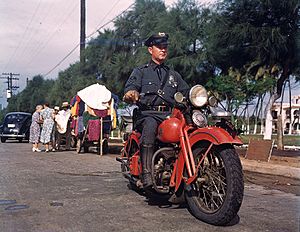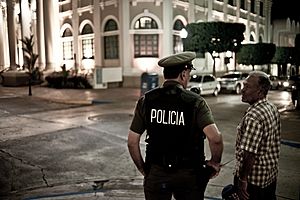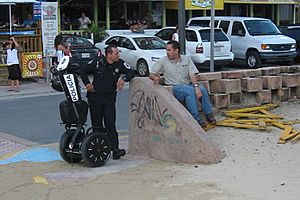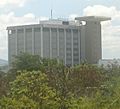Puerto Rico Police facts for kids
Quick facts for kids Puerto Rico Police Bureau |
|
|---|---|
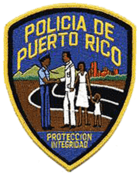
Patch of the Puerto Rico Police Bureau
|
|

Badge of the Puerto Rico Police Bureau
|
|
| Common name | La Uniformada (The Uniformed) |
| Abbreviation | PRPB |
| Motto | Integrity and Protection |
| Agency overview | |
| Formed | February 21, 1899 |
| Preceding agency |
|
| Dissolved | 1899–1956 |
| Jurisdictional structure | |
| Operations jurisdiction | Puerto Rico |
| Size | 5,324 square miles (13,790 km2) |
| Population | 3,195,153 (2018 estimate) |
| Legal jurisdiction | Commonwealth of Puerto Rico |
| General nature | |
| Operational structure | |
| Headquarters | Cuartel General, 601 Ave. Roosevelt, Hato Rey San Juan, PR 00936-8166 |
| Police Officers | 10,200 (2023 estimate) |
| Agency executive |
|
| Parent agency | Department of Public Safety |
| Child agency |
|
| Supervisions |
List
Field Operations
Management Services Professional Responsibilities Community Relations Strategy Operations Administrative Services United Forces of Fast Action (F.U.R.A.) Criminal Investigations Corps Highway Patrol Drugs and Illegal Weapons |
| Regions |
List
San Juan
Bayamón Ponce Carolina Fajardo Arecibo Aguadilla Caguas Humacao Mayagüez Aibonito Guayama Utuado |
| Facilities | |
| Districts and Precincts | 71 Districts (One station in town) 34 Precincts (more than 1 station in town) 13 Highway Patrol Areas |
| Police cars & Motorcycles | Ford Crown Victoria Police Interceptor Ford Explorer Ford Taurus Ford Econoline Ford F-250 Chevrolet Trailblazer Chevrolet Tahoe Chevrolet Impala Dodge Charger Harley Davidson Electra Glide Honda Shadow Suzuki Intruder |
| Aircraft | Bell 407 Bell 412 McDonnell Douglas MD-520N Cessna 404 Titan Cessna 310R |
| Website | |
| policia.pr.gov | |
The Puerto Rico Police Bureau (also known as Policía de Puerto Rico) is the main law enforcement agency for the entire Commonwealth of Puerto Rico. It is part of the Puerto Rico Department of Public Safety. The police handle both traffic laws and criminal investigations across the island. In 2020, there were over 11,500 police members. The police force is divided into thirteen regions to help them operate across the island. Their main office is in San Juan.
Contents
History of the Police Bureau
Early Beginnings
The first police force in Puerto Rico started in 1837. It was called La Guardia Civil de Puerto Rico. Spanish governor Francisco Javier de Moreda y Prieto created it. Its job was to protect people and their property. This force served the whole island. However, many towns also had their own local police.
After the Spanish–American War in 1898, the United States took control of Puerto Rico. On February 21, 1899, the Insular Police of Puerto Rico was formed. Colonel Frank Techner, a US Marine officer, led this new force. It started with 313 officers.
Ponce Event of 1937
On March 21, 1937, a group of people planned a march in Ponce. They wanted to celebrate the end of slavery. They also protested the jailing of Pedro Albizu Campos. About 30 police officers were sent to block the march. As the marchers sang Puerto Rico's national anthem, the U.S. appointed governor, General Blanton Winship, ordered the police to fire. This event lasted about 15 minutes. It resulted in 19 deaths. This incident, and others, made the Puerto Rico independence movement stronger. It led to protests and other events later on.
Becoming a Civil Organization
In 1980, the police force was described as a "quasi-military" group. This means it was like a military group but for public safety. Later, in 1996, the "Puerto Rico Police Act" changed this. The force became a "Civil Organization" for public safety. This made it more like police forces in the mainland U.S.
In 1993, Governor Pedro Rosselló started a program called Mano Dura Contra el Crimen. This means "Strong Hand Against Crime." In this program, the Puerto Rico National Guard helped police officers. They worked together on police tasks, but not on investigations. They were known for quick actions in public housing areas. They also used military vehicles and tactics. This program ran from 1993 to 1996. During this time, 48 police officers died while on duty. The program was used again in 2004, but not as intensely.
Modern Changes and Structure
In 2009, Police Superintendent José Figueroa Sancha changed how the Puerto Rico Police was organized. Each police area was renamed a "Police Region." Each region got two main officers. One officer managed field operations. The other managed investigations. A new goal was for officers to connect more with communities. Officers started patrolling on foot more often. This helped them talk to people and understand neighborhood problems.
In 2017, Governor Ricardo Rosselló created the Public Security Department. Héctor Pesquera became its head. This department brought many government agencies together under one main agency.
Financial Challenges
Puerto Rico has faced economic problems. The island's budget is managed by a special board. These financial issues have made things difficult for the police force. By 2019, the number of officers dropped to 6,450. Many officers retired, and there was less money for hiring new ones. In 2018, it was thought that the force needed over a thousand more officers. Lawmakers suggested raising police wages. This would help attract more people to join. Having fewer officers made it harder to prevent crimes across the island.
Police Ranks
The Puerto Rico Police Bureau has a clear rank system. The highest officer is the Commissioner.
| Rank | Comisario Commissioner |
Coronel Colonel |
Teniente Coronel Lieutenant Colonel |
Comandante Commander |
Inspector Inspector |
Capitán Captain |
Teniente Primero First lieutenant |
Teniente Segundo Second lieutenant |
Sargento Sergeant |
Agente Officer/ Agent |
Cadete Cadet |
|---|---|---|---|---|---|---|---|---|---|---|---|
| Insignia |  |
 |
No insignia | ||||||||
| Description | Governor Appointee | Bureau/ Regional/ Administrative Commander | Regional/ Administrative Commander | Regional Commander | Division/ Unit/ District Commander | District/ Precinct/ Unit Commander/Supervisor | District/ Precinct/ Unit Commander | District/ Precinct Commander | Shift Supervisor | Patrol |
The Commissioner is the top leader. The Governor of Puerto Rico appoints this person. The Commissioner leads the department and gives orders to other officers.
Before 1956, police chiefs were chosen by the U.S. government. After 1956, the Puerto Rico Insular Police became the Puerto Rico Police Department. The role of "Chief of Police" changed to "Superintendent." Since then, the Governor of Puerto Rico has chosen the Superintendent.
The Associate Superintendent is the second-in-command. This person follows the Commissioner's orders. If the Commissioner is unable to work, the Associate Superintendent takes over.
The Auxiliary Superintendent of Field Operations helps protect people and property. This role also helps keep law and order. They work to prevent crime and protect civil rights. They also help plan training for children and prevent youth crime.
Police Divisions
The Puerto Rico Police Bureau has several special divisions and units. These include:
- Highway Patrol Bureau
- Joint Forces of Rapid Action (FURA)
- Motorized Impact Unit
- Robbery and Bank Fraud Division
- Security and Protection Office
- Special Arrest and Extraditions Division
- Tactical Operations Division
Police Resources
Air Support Unit
The Air Services of the Puerto Rico Police Department are run by FURA. FURA stands for Fuerzas Unidas de Rapida Accion, which means "Joint Forces of Rapid Action." This unit provides air support to police on the ground.
The air unit started in 1963. It was based at Isla Grande Airport. Back then, it used Fairchild Hiller FH-1100 and OH-23 Raven helicopters. In 1986, the unit became part of FURA. They got new helicopters like the MBB/Kawasaki BK 117 and MD 500. Some of these were very advanced for police work.
In 2000, the air unit received three new helicopters: two Bell 407s and one Bell 412. The Bell 412 was set up for many missions, including rescue. In 2006, FURA got two more new Bell 407 helicopters. These had advanced technology. They included powerful searchlights and heat-seeking cameras. These cameras can find people even if they are hidden. They can also see a car's license plate from far away. The system can send live video to ground units.
Today, the Puerto Rico Police air fleet includes 3 Bell 429s, 3 Bell 407s, and a Baron twin-engine airplane. The air division has two districts: Northeastern and Southwestern. The Northeastern district covers from Aguadilla to Yabucoa. The Southwestern district covers from Maunabo to Rincon.
The Air Services unit does many jobs. These include helping ground units, patrolling the coast, and performing search and rescue missions. They also assist in SWAT exercises.
Communications Systems
The Communications Division helps the police stay connected. It has sections for trucking systems, special services, and radio repair. Each police region has staff from these sections. They provide communication support to the department.
The Puerto Rico Police use radio communications on VHF, UHF, and 800 MHz frequencies. Their radio system was updated to a modern P-25 phase 1 Atlas system. This system has 20 towers to cover the whole island. There are also systems that allow different radio types to talk to each other.
The 13 police regions also use an 800 MHz digital system. There is a backup VHF system with 13 repeaters around the island. The police have 13 control centers, one in each Police Region. There is also a main Command Center in FURA. The Radio Control Center monitors all police regions and units. It also helps coordinate resources. The Puerto Rico Police use Ten-code for radio communication.
Ground Transportation
The police use many types of vehicles for their work.
Police Uniforms
The uniforms of the Puerto Rico Police have changed over the years. In the 1930s, officers wore long-sleeve, navy blue shirts. They had a gun belt around their waist. Their navy blue pants had a black stripe down the side. In the 1960s, the gun belt changed, but the rest of the uniform stayed similar. The patch then showed the Great Seal of Puerto Rico.
In the late 1980s, the uniform changed to a light-blue, short-sleeve shirt. The police patch changed to show an officer saluting a family. Behind them were a city and mountains. This patch is still used today. In 2004, a new patch was introduced. It showed a male and female officer with the U.S. and Puerto Rico flags. This patch is not as popular as the older one.
Today, officers wear light-blue shirts, either long or short-sleeved. They wear navy blue pants with a black stripe. Higher-ranking officers, like lieutenants and captains, might wear white shirts. Officers wear either a black peaked cap or a black police stetson hat.
Special units, like the Mounted police, have slightly different uniforms. They wear light-blue shirts, often with long sleeves for ceremonies. For coastal patrol, they might wear short sleeves or a navy blue long-sleeve shirt that says "Policia" on the back. Their pants have a yellow stripe and are worn with riding boots.
Weapons and Vests
The Puerto Rico Police use various types of weapons and protective gear.
Lethal Weapons
- Smith & Wesson Model 10 (no longer used)
- Smith & Wesson Model 28
- Smith & Wesson Model 686
- Smith & Wesson M&P
- Smith & Wesson Model 5906
- Glock 22
- Sig Sauer P320 9mm (main service weapon)
- SIG Sauer SIG516 (10.5” 5.56 NATO)
- M-14
- Remington 870
Non-Lethal Weapons
- Taser Gun
- Plastic Bullet Gun
- Blank Gun
- Straight Stick
- PR-24 side-handle baton
- Expandable Baton
- Tear Gas
- Pepper Spray
Bulletproof Vests
- Type 3A Bulletproof Vest
- Type 2 Tactical Vest
In Popular Media
The Puerto Rico police have been featured on TV. They were shown on The Travel Channel's reality show, Border Rico.
Images for kids
See also
 In Spanish: Policía de Puerto Rico para niños
In Spanish: Policía de Puerto Rico para niños


